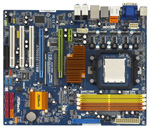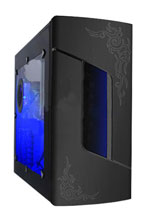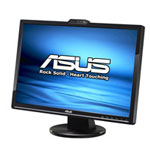Phenom II Entry
With Intel and AMD price reductions and AMD filling out the Phenom II line you can now buy a Phenom II CPU for as little as $119. With Phenom II pricing that low you can put together an entry Phenom II system for a very low price and still expect amazing performance and superb value.
If you look back at the earlier System Buyers' Guide: PCs for Under $1000, you will find our cheapest AMD system, based on the $63 Athlon 64 X2 505E Brisbane, had a base system price (before monitor, speakers, input devices and OS) of $324. Today's Phenom II Entry PC is two generations more recent, 3 cores, and 6MB L3 cache. It achieves much higher performance than the Athlon 64 X2 system and yet the base system cost is just $40 more. That represents phenomenal value and bang for the buck.
 |
Prices on all processors are continuing to drop in the face of the continued, aggressive pricing strategy adopted by Intel. The new AMD Phenom II 710 is priced at just $119, but that $119 gets you a 2.6GHz triple-core CPU with each core featuring 512KB of L2 cache (total 1.5MB). The three cores share the same 6MB L3 cache as the more expensive X4 Phenom II chips. Performance in our tests was generally competitive with the Intel Core 2 Quad at $170 and the AMD Phenom X4 9950 at $148. Clearly, the 710 is a good value at $119.
 |
The 780G chipset is one of the best budget IGP designs we have worked with over the years. This is the chipset that made integrated graphics relevant again. One of the best boards in this price category is the ASRock A780GXE. The A780GXE features the ATI Radeon 3200 integrated graphics. ASRock loads the board with six 3Gb/s SATA ports featuring RAID 0/1/10, 5.1 HD audio, Gigabit LAN, two PCI-E x16 slots, one PCI-E x1 slot, three PCI slots, and support for 16GB of memory. Durability is addressed with solid capacitors for CPU power and duracap long-life capacitors for the rest. This board has been rock solid for us and supports AM2/AM2+ and AM3 (running DDR2) CPUs.
The A780GXE has 128MB of sideport memory for additional performance. It fully supports the Phenoms I and II, and it can do dual x8 CrossFire. The A780GXE used to be a $100 board, so it is a good value at the current $80 price. If you are really pinching pennies ASRock also manufactures the A780FullHD motherboard, which is $23 less at $57. The cheaper ASRock is a Micro ATX board where the 780GXE is full ATX, and the A780FullHD does not support CrossFire. The A780GXE is the better value for most users, but if every penny counts you will not be disappointed in the performance of A780FullHD. Both boards are among the best values ever seen in the motherboard market and are solid performers.
 |
The case and power supply are the Sigma 500W La Vie Mid Tower. This case and power supply are currently on sale after a $25 rebate for $40. Sigma makes both decent cases and decent power supplies that are sold separately. While no one will mistake this case/PS combo for one of the premium Sigma offerings, it is still good quality and good value for a very reasonable price. Even if you pay the regular price of $60 to $65 you will get good value in this combo. We have built several entry systems with the Sigma case and PS and had good results and stable performance. The only caveat is to check out the case when it arrives as shipping can take its toll on the case front door.
You should generally go for the best case and power supply you can reasonably afford, so you should also look at the Phenom II OC choices of the Cooler Master Centurion and the top performing BFG Tech 550W in our recent roundup that would add just $70 to the total system price. That upgrade would be a good base for any entry to upper midrange computer system.
 |
With DDR2 prices so very low, we went for 4GB of DDR2-800 this time. This is double last year's entry recommendation for less than half the price. This 50% to 75% drop in DDR2-800 memory prices in the past year is why you're not seeing much memory advertising these days. RAM prices as a whole are certainly in the commodity category as of late. We recommended the Kingston 4GB DDR2-800 kit, but you could just as easily choose OCZ, G.Skill, Corsair, Crucial, GeIL, Patriot, or any other quality DDR2-800 name and shop for the memory based on a combination of price and the company's support reputation. Again, if you are truly pinching pennies you can save about $13 by going with 2GB of memory instead.
Hard drive capacity continues to grow, as you can see in our selection of the Western Digital Caviar 500GB for our entry system. It seems a waste to choose a lower HD capacity when 500GB is now available for around $60 - even from
www.amazon.com. While there are differences between hard drives, outside of running benchmarks most people aren't likely to notice the variation in performance between Western Digital, Seagate, Samsung, Hitachi, and other major brands. All are worthy of consideration if the price per gigabyte (or terabyte) is right.
For the optical drive we went for value with the dependable Samsung 22X DVDR. With the rise of the 25GB/50GB Blu-Ray burners, DVD writers have continued to drop in price. A DVD writer that supports double-layer and 22X DVD writes for $24 is a bargain indeed.
With the greater performance of the Phenom II Entry system, we have balanced it with a better monitor. The LCD display resolution for the Phenom II Entry system is a nominal 22" 1680x1050 LCD from ASUS for just $150. The monitor is one of the new class of monitors that more honestly report their true size and this 21.6" display would have been called a 22" by many manufacturers. This ASUS VK221D provides a lot of LCD at a tiny price in the entry system.
If you prefer a full 1080p HD monitor the ASUS 21.5" 1920x1080 LCD is available for just $30 more at $180. If you are pinching pennies you can get by with the smaller 17" Hanns-G HB-175APB 17" 8ms Widescreen LCD Monitor with 1440x900 resolution for just $99. You can also do away with speakers and save another $18 if you can live with the speakers built into the monitor.
Finally, Vista Home Premium OEM runs the system, but you could opt for an OS alternative like Ubuntu and save some money if you prefer. With Ubuntu or a similar free OS, the price comes extremely close to $500, which is awesome for a complete system packing this much performance.

















49 Comments
View All Comments
genpat - Monday, March 2, 2009 - link
All sorts of messed up links on overclocking page as wellWesley Fink - Monday, March 2, 2009 - link
The links were added by web editors in the final prep for posting. I have been checking links and correcting them where I find errors.Frallan - Monday, March 2, 2009 - link
However only 4-8 Gb Memory. Is this for a reason i.e. does the system perform worse with 16Gb installed?
Wesley Fink - Monday, March 2, 2009 - link
With 4 dimm slots you would need 4GB dimms to populate the board with 16GB. The only 4GB dimms readily available are the Kingston 8GB DDR2-800 CAS6 kit in DDR2. They sell for over $400 for two dimms (8GB), or $800+ for 16GB.We're not opposed to more memory, but 16GB is really not very practical right now.On the Overclocking systems generally the more memory slots filled the more limited the memory overclocking capabilities. Filling two slots with fast 2GB dimms (total 4GB) seemed the best formula for best overclocking potential. We didn't even consider 8GB (4x2GB) as an option for the OC systems. Since the Entry system is about price and value we also did not consider 8GB there.
marc1000 - Monday, March 2, 2009 - link
honestly, more than 4gb for home use is a waste. I have two rigs at home (one for me, the other for my girl). Mine is 4gb and her is 2gb. With dual-core cpu's and 4gb of memory you will never have a performance-wise problem on your computer. Of course you may always want the "better and fastest", but only a few percent of users are concerned about that. The vast majority only want to use some Word-app and read some emails.Also, for these folks 32bit and 64bit OS are exactly the same things. With Windows Vista hard-coded limitation to only 4gb, there really is no need to go beyond 4gb. By the way, my OS is 32bits so I'm "loosing" 700mb to this artificial limit (and I will replace a hidden DLL soon to make it use the full 4gb).
DeepBlue1975 - Thursday, March 5, 2009 - link
So true.Had 6gbs on my machine for a while (had 2, then added 4 more), and as soon as I compared the performance delta between that and 4gbs, I ended up selling the old 2gbs so I now have just 4gbs. It is plenty for my usage pattern.
Also I don't get why the editor seems to implicate that a mid range CPU such as a phenom II will be mostly paired to pretty low end devices for anything.
I mean, come on, even if you're only an ocassional gamer, an IGP won't cut it. I don't see that even as well fitted enough for watching HD movies.
v12v12 - Wednesday, March 4, 2009 - link
"Hidden DLL" you say? Please do explain/expand for those that don't already know.JarredWalton - Monday, March 2, 2009 - link
Only Vista 32-bit has a 4GB limitation; that's the whole point of 64-bit OSes. Of course, only 64-bit apps can access more than 3GB even on Vista 64-bit... perhaps that's what you meant? (I still curse Adobe on a regular basis for their lack of 64-bit applications!)Ryan Smith - Tuesday, March 3, 2009 - link
Close. 32bit apps that are LargeAddressAware can hit up to 4GB under Vista x64.This doesn't include the other benefits of more memory of course, such as additional applications being able to use their own chunk of memory without having to share with other memory-intensive applications.